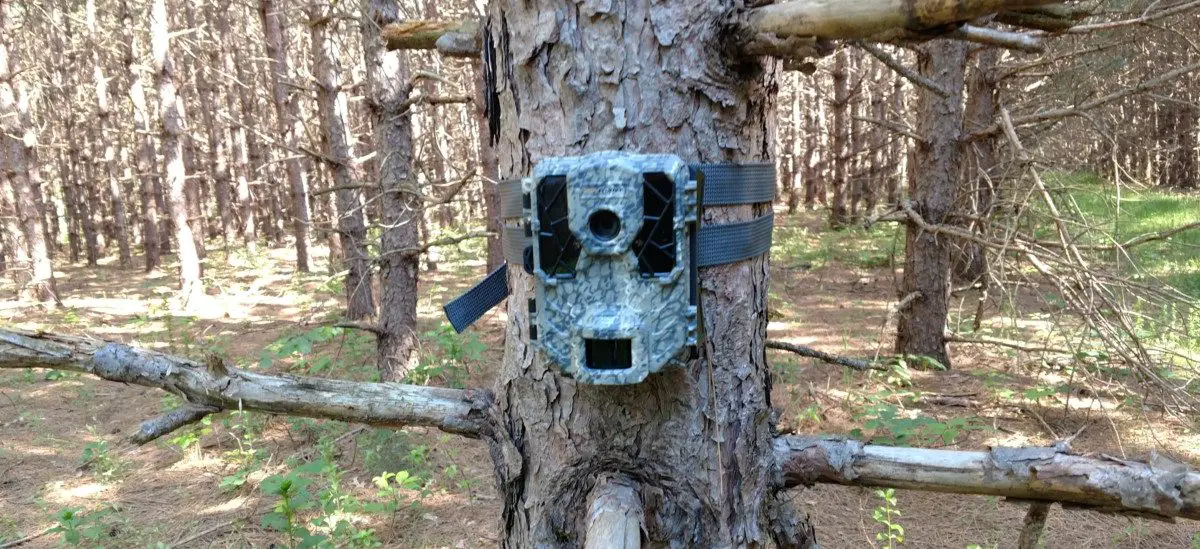The Spypoint Force Dark is a mid level trail camera with easy to use features, that is well engineered with fast trigger speed and recovery times, and is backed by a 2 year manufacturer warranty. We put this camera to the test, and broke down each aspect to find out what it can really do. It fared decent in many areas, but lacked quality particularly in night time photos and video quality.
Our final score for the Force Dark was 65/100. Take a look at our in-depth review to see if this is the right trail camera for you.
| Score | Comments | |
| Design | 7/10 | Durable, Nice Color Pattern, Excellent latch for the housing unit |
| Ease of Use | 6/10 | Easy to use, but the settings don’t explain what you are setting the camera to do |
| Features | 8/10 | A lot of available features to make this camera operate the way you want it to |
| Daytime Picture Quality | 6/10 | Vibrant colors, but excessive amount of noise in the photos |
| Nighttime Picture Quality | 4/10 | Quality Low light photos, but a lot of motion blur in night time photos |
| Video Quality | 5/10 | Filmed at only 10 Frames Per second |
| Time Lapse Mode | 6/10 | Can not set the time lapse mode to work at two different times of the day. |
| Engineering | 8/10 | Fast Trigger Speed, Long battery Life |
| Price | 7/10 | Price point for this camera is right in line with comparable models in the industry |
| Warranty/ Customer Service | 8/10 | 2 year warranty, solid customer service |
| Total | 65/100 |
How We Review Cameras
When it comes to online reviews, there is nothing more aggravating than reading a review from someone that simply copies and pastes the manufacturer’s provided information. We vow to never write a review of any product that we do not own, use, and test first hand.
How we review a camera is simple: we put them in the field and let them perform. There is no better way to see how a trail camera works then allowing them to do their job. Only after we have had enough time to test every setting and feature, we give them a grade.
We break down the camera into ten separate categories from design and features to image quality and ease of use, then grade each one based on our 20 point checklist. The overall grade is based on an accumulative score from these 10 categories.
Oh, and we grade tough. Just like that high school teacher that you had that never gave out an “A”, we believe there is always room for improvement, and the perfect camera has yet to be made. So, don’t expect many cameras to be in the 90’s.
Manufacturer’s Specs
| Megapixels | 12 MP | Power | 8 AA |
| Number of LED | 42 | External Power | DC 12 volt |
| Flash Range | 90′ | Detection Distance | 110′ |
| Trigger Speed | .07 sec | Flash | No Glow, Optimal, Boost, Blur Reduction |
| Time Lapse | Yes | Time Stamp | Date, Time Moon Phase Temperature |
| Photo Burst | Up to 6 | Mount | 1/4″-20 |
| Video | 1080p | Dimensions | 3.8″ x 5″ x 3.2″ |
| Sound Recording | Yes | Warranty | 2 Year |
| Memory Card | Up to 32GB | MSRP | $129.99 |
Design
Score : 7/10
The Spypoint Force-Dark seems bulky in the hand, and with the use of the detachable mounting bracket makes the camera stick out from the tree even more, making it a bit tricky for concealment. The battery tray is located in the back of the camera, forcing you to detach the camera from the bracket when needing to change batteries. We did however like the camera’s camo pattern, making it easier to blend in with the surrounding environment. The large latch on the housing door is a plus as well, as it makes it easier to open with cold hands.
Appearance
Size
Spypoint’s manufacturer’s dimensions of the Dark- Force is 3.8″ in width, 5″ in length, and 3.2″ in depth. When we put the calipers on it, the camera itself measured slightly larger at 3.9″ W x 5.1″ L x 3.3″. That extra 1/10th of an inch is not that big of a deal, but if you add the mounting bracket, which they promote using with the camera, the depth the camera sticks out from the tree measuring at 3.8″ in depth making it almost as deep as it is wide.
Color
We loved the color of the Force -Dark. The green opti-fade pattern blends well with many different types of surroundings in the woods. This color pattern is a much needed upgrade to the traditional 3D camo patterns that most trail cameras use
Mounting

It comes with a detachable bracket that secures to the tree and the camera simply snaps into. I started out hating this feature as it held the camera away from the tree, making it harder to conceal.
Once I began to use it in the field I began to enjoy the ease of hanging just the light bracket then placing the camera on it. There is nothing more frustrating than trying to hold a camera against a tree while working the buckle on the back side of the tree. This detachable bracket eliminates that frustration.
If in the end you find that you don’t like the use of the bracket, you can still eliminate it and hang the camera as you normally would, which is a nice alternative option. The drawback to this however is that the placement of the battery compartment is on the back of the camera, and in order to get to it you would have to completely detach that camera from the tree, and take the strap off the camera.
This camera also has 1/4-20 threads on the bottom of the camera so you can mount it with the use of a third party mount. It doesn’t have a second thread on the back, due to the placement of the battery compartment. When available, I tend to use the back threads more often, so as a personal preference this is a negative, but the lack of a second thread didn’t affect its score.
Battery Compartment

As you can probably tell at this point we were not a fan of the location of the battery compartment on the back of the camera. It simply creates too much fumbling around at the tree. It does however hold the batteries in tightly, and are easy to take out and put back in. Not having a tray for the batteries cuts down on the amount of noise you make when changing out batteries as well.
Latches
The door to the camera housing is the size of the entire camera. When trail cameras are designed like this you often find that manufacturers will use two small latches. What Spypoint has done with the Force-Dark is created one larger latch that has two tightening points. This is really well designed as it keeps the housing door latched tightly in two locations in order to keep water and debris out, while creating a more ergonomical latch, especially when with cold hands.
Durability
Aside from the mounting bracket that is made of a simple molded plastic, that we feel could break with repeated use, this camera is built very well for durability. Other than the mounting bracket, we found no glaring issues with the durability of the camera, and had no problems with it in the field.
Ease Of Use
Score: 6/10
The Force- Dark is very simple to setup. The basic design of having just a handful of menu options, makes going through the camera and setting it up quick and painless, especially for a new user. It did however have a few hiccups that made things a little confusing. Some of the individual features use words like High quality and Fast trigger speed, rather than giving us a clear understanding of what that means.
On / Off
One thing that we wish that Spypoint would include is an on off switch. In the end its not a deal breaker with this camera, but they require you to hold the “OK” button to turn the camera on and off. This could create a little problem when selecting options within the menu screen with the OK button. If you hold your selection too long, you will ultimately turn the camera off.
General Settings Menu
What we like is the ability to control almost all of the settings in the camera in one easy to use menu. Simply scroll down and change each setting. With that said what stands out to us that the terms on each setting is very vague, for instance the photo quality options are “normal” or “high.” What exactly that means we are not sure. We know it probably adjusts the interpolation of the megapixel count, but not sure what we are setting it to.
The trigger speed also does the same thing, giving us options of “fast” and “optimal.” This can be confusing as we are not sure what we are adjusting it to.
Setting Trail Camera Modes
Setting the different modes of the trail camera is fairly simple. Inside the setting menu it offers the 3 basic options: Photo, Video, and Time Lapse. You can select which setting you want, and adjust the settings for each one.
Photo
Inside the photo menu option you can choose the Delay in between triggers, and the amount of photos you would like. We wish you could also set the photo quality in this menu, but that setting is only adjusted in the general settings menu. Forcing you to go back and forth in the menu options to set the photo mode.
Time Lapse
Much of the same with the Time Lapse menu. The only thing that you can control from this option is the interval. In order to set the start and stop times, that feature is found in the general settings menu as well. Again making setting this option to your specifications, a bit frustrating.
Video
The Video settings menu gives you the ability to control both the delay and the video length. Since, there is only one video resolution option on the Force-Dark, that is all you need to set the video. What we don’t like however is the hybrid mode of this trail camera is found in this menu, instead of in its own menu
Starting the Camera
Once you set all the settings you want, you can easily start the camera from the home screen. Once you select start the camera, from there you have the ability to select which mode you want the camera to use.
Features
Cumulative Score : 8/10
The Spypoint Force Dark is absolutley loaded with features. From adjustable flash power to trigger speed and PIR sensitivity, this camera has the ability to set it up to how you want it. The only thing that it does not offer is an adjustable video resolution or the frames per second it films in.
Photo Settings
The only Megapixel setting on the Force Dark is 12 MP, which is a bit frustrating as someone who likes to set the Megapixels closer to the Native Image Sensor size. However, it allows you to set the photo quality from Normal to High. Visibly we could not tell the difference between the two settings, and were unable to receive an informative answer from Spypoint on exactly what this setting does. But it is there if you want to change it. Other settings that are available through the Photo settings are the delay, and photo burst.
| Settings | Options |
| Delay Settings | Instant, 10s, 1min, 3min, 5min, 10min, 15min,30min |
| Photo Burst | 1-6 Images |
| Photo Quality | High / Normal |
Video Settings
The Video recording is a little bit confusing. The owners manual claims that the video is recorded at 1280 x 720, then in parenthesis says (1080p). While 1080p is recorded at 1920 x 1080, this camera is indeed recorded at 1080p. There is no adjustment on this however, as you can only shoot video at this resolution. The settings that are available to change in this menu option are the Delay, video length and the ability to use Hybrid mode.
| Settings | Options |
| Delay Settings | Instant, 10s, 1min, 3min, 5min, 10min, 15min, 30min |
| Video Length | 10s, 30s, 60s, 90s |
| Photo First | On / Off |
Time Lapse Mode
The Time Lapse mode if very simple and straight forward. Exactly like you would see from any other camera. You have the ability to change the interval of photos anywhere from from 1 minute to 24 hours in between photos. You also can set the start and stop time, making it available to set up at dusk or dawn.
General Settings
The general settings menu allows for you to adjust or change the normal settings such as time, date, and the name of the camera. Aside from those typical settings you have the ability to set the Quality of the photos, the sensitivity of the PIR sensor, trigger speed, and flash mode.
Our biggest problem with all of these settings, aside from the flash mode, is that it doesn’t tell you what you are setting the camera to. After reaching out to Spypoint to get specific answers of what each option means, we were still left in the dark about what the options change to.
| Setting | Options | Lingering Questions |
| PIR Sensitivity | Normal, High, Low | This is self explanitory |
| Photo Quality | Normal, High | What does high quality do to the photo? |
| Trigger Speed | Fast, Optimal | What speed is fast, and what is optimal? |
As you can see, for someone who is trying to set their camera up for their liking, it is hard to know without messing around with the settings, how fast the trigger speed is, or the quality of photo is best.
With the flash settings however, there is much more detail on how each setting works, which is helpful, and much appreciated.

Daytime Picture Quality
Score: 6/10
The only way to truly tell the quality of photos is to look for yourself.
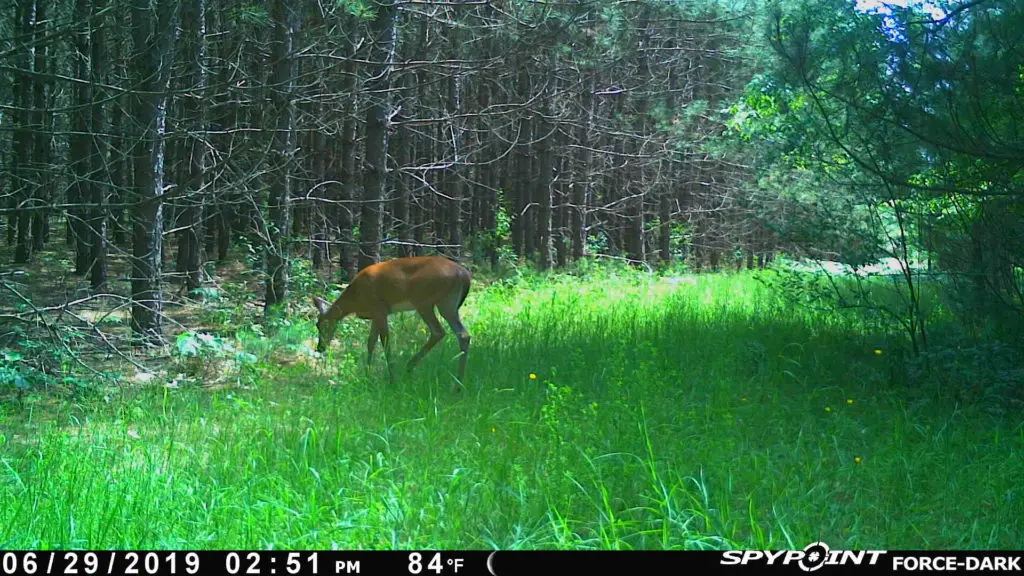
There are two things that stood out to us when it came to daytime photo quality: the vibrant colors, and the noise that the photos had. While these two might seem a bit contradictory, if you look at the photos carefully you will see that the colors are very sharp, but the images of the deer and turkey are a bit grainy.
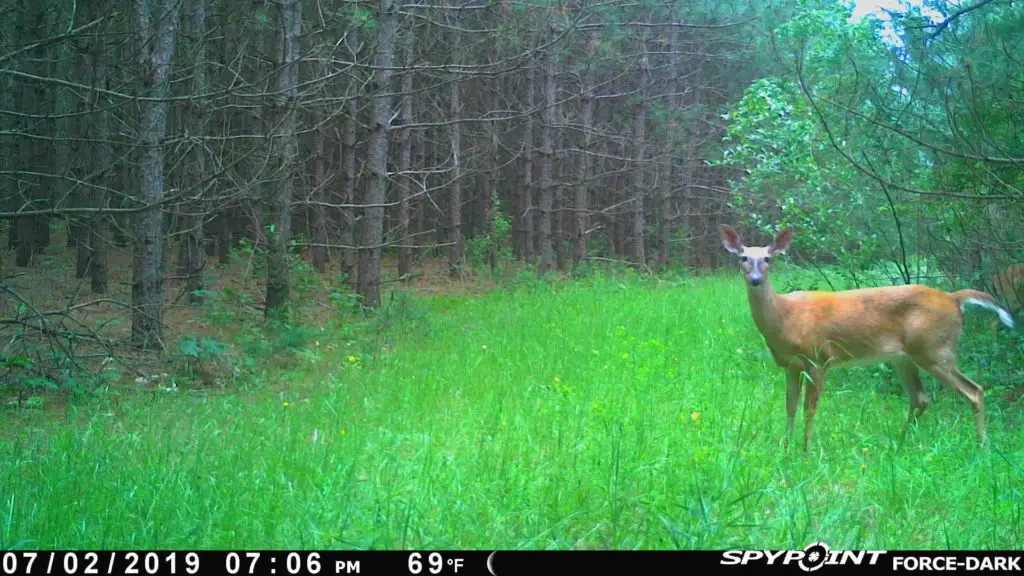
The reason for the grain is actually very simple, and it comes down to the exposure tables on the back end of the camera. Spypoint made the Force-Dark to be super fast, meaning as a part of the speed in which the camera takes pictures, they need a quick shutter speed. That fast shutter speed, while captures objects in motion well, it leaves the need for more light in the photo. So, on the back end of the camera they turned up the ISO.
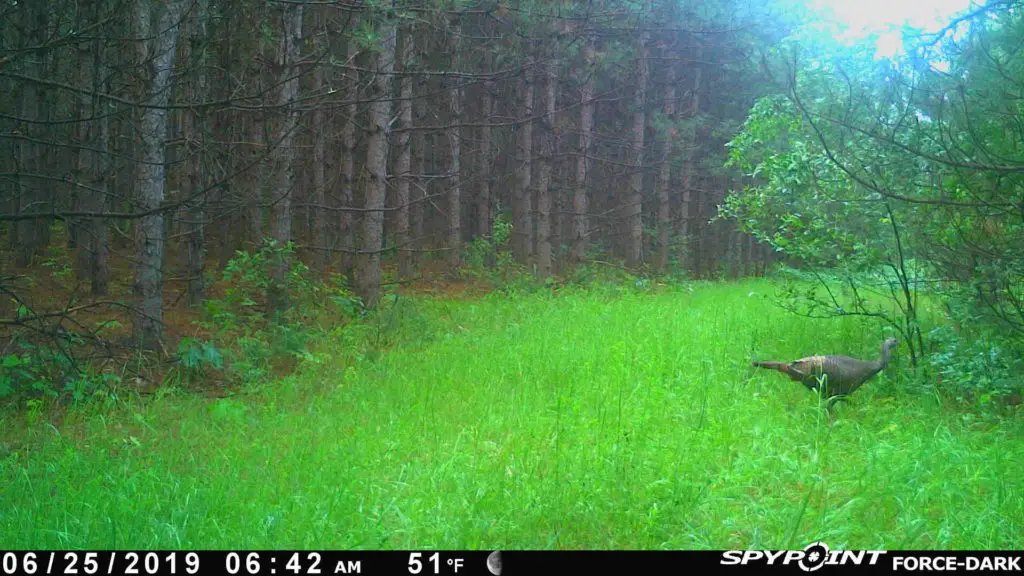
The ISO is basically the sensitivity the camera has to light. While it is a helpful tool, the higher the ISO the more noise, or grain, you will see in the photo. All of this is a by product of using a lighting fast shutter speed.
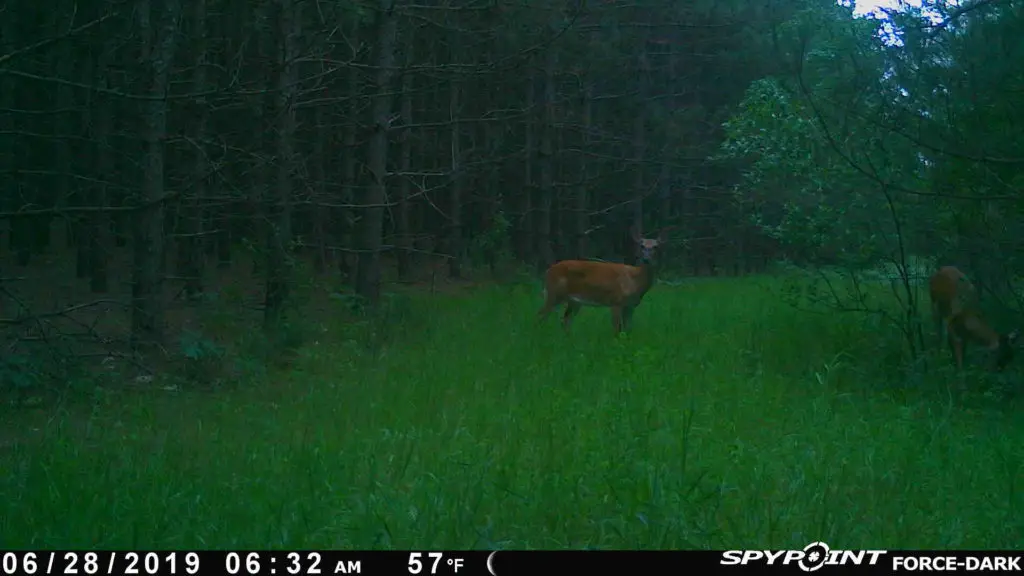
While we would have liked to see the ISO turned down a bit for photo clarity, if you are in need of fast trigger speeds, this is just a trade off.
Nighttime Picture Quality
Score: 4/10
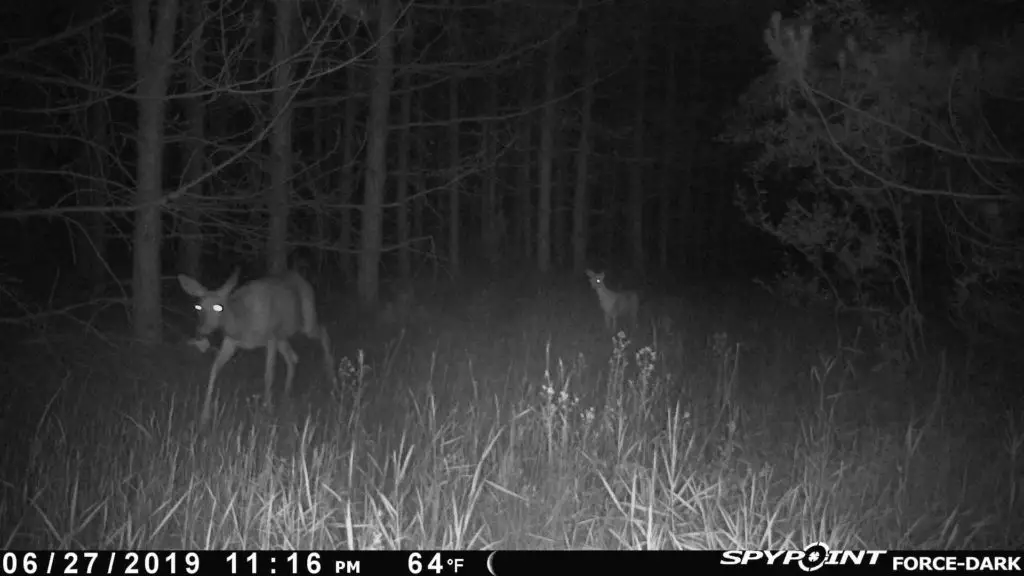
The night time photos are anything but good quality. There seems to be adequate amount of flash, but light seems to be stronger in the center of the photo than it does along the edge of the field of view. This seems to give the images a sort of halo affect on the photos.
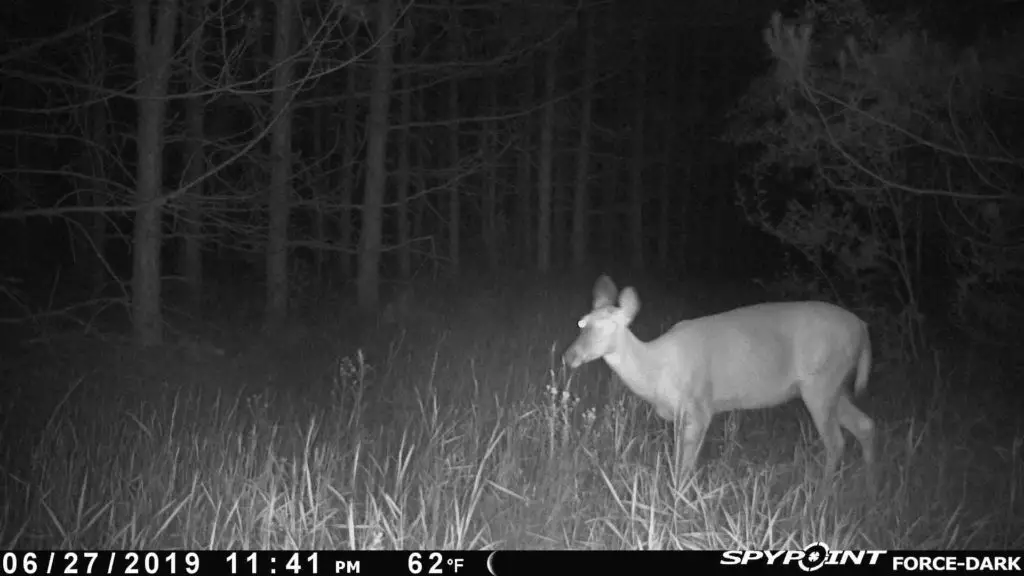
Motion blur was a huge problem. Even with a solid back drop for the light to reflect back into the photo, there seemed to be a consistent problem with movement. Even the blur reduction mode on the flash didn’t seem to help, as the shutter speed for night time photos was too slow to keep the image from being blurry.
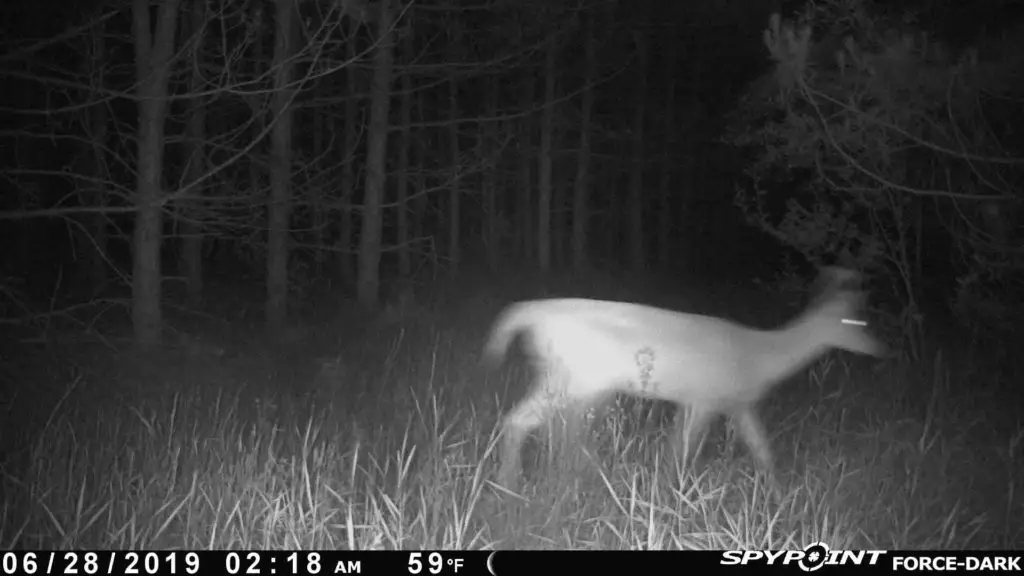
On a positive note, this camera did very well in low light conditions, which is where most trail cameras struggle. There is nearly the perfect combination of flash and trigger speed, that kept any motion blur from forming in the photo. The photos were a little dark, but that is to be expected during these lighting conditions.
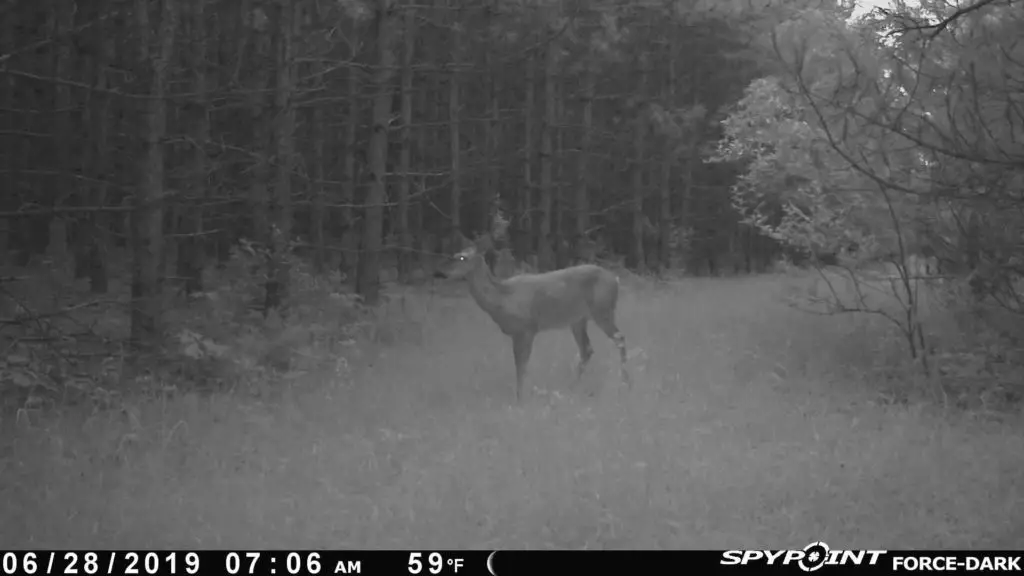
Video Quality
Score: 5/10
When it comes to video quality there are essentially two things that are the building blocks for good videos: resolution and frames per second. The resolution on the Force Dark is Full HD 1080p, which is a plus. The frame rate in which the video is recorded however is only at 10 frames per second. The low frame rate per second makes the videos choppy, compared to the industry normal of 30 frames per second.
The color and clarity in the video is decent, but the microphone on the audio portion of the video mostly picks up wind noise. Overall the video feature is subpar.
Time Lapse Mode
Score: 6/10
With Time Lapse Mode you essentially get the same type of settings and performance from every trail camera on the market. We like how you can set trigger intervals anywhere from 1 second all the way up to 24 hours, giving you the flexibility to customize it exactly how you want.
What we didn’t like is that they only offer one time frame throughout a 24 hour period in which you can activate the camera. Meaning you have to choose between either dawn or dusk, and there is no option to be able to set the Time Lapse during both periods.
Engineering
Score: 8/10
The overall engineering of the Force-Dark is really well done. From a fast trigger speed and incredible battery life to a long detection distance and a decent no glow flash distance, this camera was engineered to be a quality camera.
Trigger Speed
The .007 second trigger speed that Spypoint promotes is a little misleading. The true definition of trigger speed is measured from the time an animal moves into the detection zone to the time the photo is captured. Spypoint however, defines trigger speed to be the amount of time it takes the trail camera to come out of “sleep mode.” So the .007 second trigger speed is actually a completely different measurement than what any other trail camera uses.
With that being said, the Force-Dark still has an incredibly fast trigger speed. At no time during our year of testing this camera did we get photos of the back end of a deer, due to lagging of trigger speed. The first photo of each series, was right on point, making that aspect of this camera of very good quality. The recovery time of the trail camera is almost instant, making multi shot settings very effective.
Battery Life
Using 8 AA Lithium ion batteries, over the course of an entire year of testing the Force- Dark, we never had to change batteries. Using every setting from video, photo, to time lapse, and increasing flash power, and trigger speed, the battery indicator never came off full. This is a huge plus for anyone who is in search of long battery life.
Detection Distance
Spypoint claims that the detection distance is around 110 ft. With an extensive test, we were able to get a photo to trigger at 112 ft. This is an incredible distance for any camera. This works really well during day time photos, especially around a foot plot or open field where a deer might not be a close to the camera.
The only knock we have on the detection distance, is that the flash distance doesn’t match it. With No Glow flash, its hard to get a long flash distance, but during nighttime photos we had multiple occasions when the camera triggered a photo, only to be able to see just a rough outline of a deer beyond the lighted area.
Odds and Ends
We have all had those times when we are setting, or checking a trail camera,and in a hurry we forget to turn turn the camera from the setup menu to on. Only to return 2 month later to no photos and the camera is still in the menu options. With the Force- Dark this never happens. When there is 2 minutes of inactivity in the setup menu, the camera automatically switches to camera mode, saving you from your own mistakes.
Price
Score: 7/10
The Spypoint Force-Dark has an MSRP of $129.99 as listed on the manufacturers website. You can find this camera, however, on Amazon for $119.99. This price seems to be on par with other comparable trail cameras like the Browning Dark Ops Extreme which is at the same price point. You are not going getting an amazing deal, yet you are not getting ripped off either.
Warranty/ Customer Service
Score: 8/10
The industry standard for warranties on trail cameras is 1 year. All of Spypoint’s trail cameras come with a 2 year “no you are covered” warranty. Here is their warranty policy:

While we never had any problems with the Force-Dark, I wanted to see how their customer service fared when it came to helping with problems. So I made up an issue I was having with the camera and gave them a call. The person I spoke with was both helpful and knowledgeable about the camera, and walked me through how to trouble shoot my issues.
Conclusion
Final Score: 65/100
Here is a quick recap of some of the pros and cons of our testing:
Pros:
- Large easy to use latch
- Fast Trigger and Recovery Speeds
- Great Battery Life
- Ease of Use
- Above average Warranty
Cons:
- Location of battery compartment
- Poor Night Time Photos
- Poor video quality
- Only one time option for Time Lapse Mode
- Motion Blur especially in night time photos
If you are simply looking for a trail camera that has a very fast trigger speed and incredible battery life, the Spypoint Force-Dark is a great option to add to you trail camera lineup. However, if you use ever use your cameras in video mode, or get a large percentage of night time photos, this camera performed poorly in those areas.

